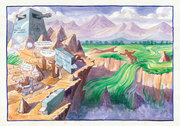
I wanted to connect and integrate ideas on Personal Learning Networks (PLNs) with the flow of information and knowledge through my learning ecology. Using my PLN I discovered the Seek-Sense-Share model of information flow developed by Harold Jarche(1) to represent the way we set out to find information that is relevant to our learning and development projects, make sense and use that information then share with others our understandings.
According to Harold, Personal Knowledge Mastery (PKM) is a framework for individuals to take control of their professional development through a continuous process of seeking, sensing-making, and sharing.
Seeking is finding things out and keeping up to date. Building a network of colleagues is helpful in this regard. It not only allows us to “pull” information, but also have it “pushed” to us by trusted sources. Good curators are valued members of knowledge networks.
Sensing is how we personalize information and use it. Sensing includes reflection and putting into practice what we have learned. Often it requires experimentation, as we learn best by doing.
Sharing includes exchanging resources, ideas, and experiences with our networks as well as collaborating with our colleagues.

I like this representation as it converts an abstract model into something tangible.
I decided to personalise Jane's approach and the result is shown in the illustration below. Unlike Jane's disciplined daily routine, my approach to accessing the information flow from my PLN is quite chaotic. But it becomes more disciplined and systematic when I want to learn something. I dedicate the time and resources to SEEKING information that might be relevant (such as what I'm doing now) for a particular purpose. In other words, while this model explains the ongoing information flows in my life, it comes into its own when I have created an ecology for learning something(3).

In accessing the information I make a judgement as to its relevance, validity and utility and then I either store it or put it to use by bringing it into my learning project. Through a process of trying to understand and apply the information SENSING, I create new meaning and change my own understandings which I can SHARE via my Twitter accounts or through my websites and the on-line publications I help produce, if I think other people will be interested or, it advances my own projects, The value of CURATING as part of the infrastructure for sharing is that it provides a context to enable deeper understandings to be made.
Through this illustration I can visualise how my PLN has two different dimensions. The first is to provide me with a continuous flow of information that might be of interest and which I might be able to make use of. But once I engage with a problem I actively begin to create an ecology within which my PLN will take on new meaning as I SEEK specific individuals inside or outside my existing PLN, who can provide me with information that is relevant to my learning project. This is a transactional relationship in which I commit to SHAING some of what I have learnt with the people who include me in their PLN or who in future engage in their own SEEKING for information that I have shared. This is how the ecology of information works.
SOURCES
1 Jarche H, (2014) The Seek > Sense > Share Framework Inside Learning Technologies January 2014, Posted Monday, 10 February 22 014 http://jarche.com/2014/02/the-seek-sense-share-framework/
2 Hart J (2013) My daily PKM routine (practices and toolset)
http://www.c4lpt.co.uk/blog/2013/11/30/my-daily-pkm-routine-practices-and-toolset/
3 Jackson, N. J. (2013b) Learning Ecology Narratives, in N. J. Jackson and G. B. Cooper (eds) Lifewide Learning, Education and Personal Development E-book Chapter C4 available on line at: http://www.lifewideebook.co.uk/research.html








 RSS Feed
RSS Feed